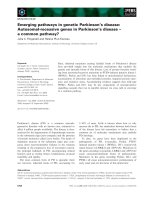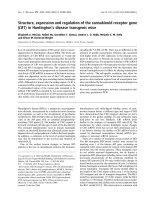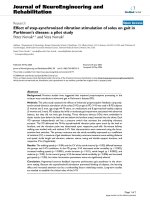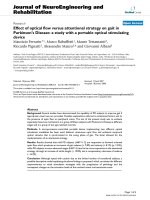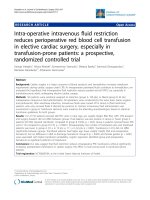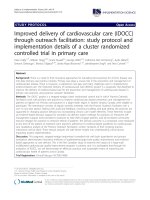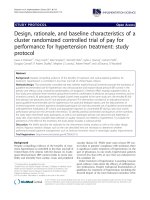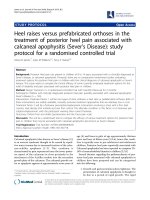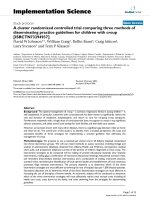Music therapy in Huntington’s disease: A protocol for a multi-center randomized controlled trial
Bạn đang xem bản rút gọn của tài liệu. Xem và tải ngay bản đầy đủ của tài liệu tại đây (752.04 KB, 9 trang )
van Bruggen-Rufi et al. BMC Psychology (2016) 4:38
DOI 10.1186/s40359-016-0146-z
STUDY PROTOCOL
Open Access
Music therapy in Huntington’s disease: a
protocol for a multi-center randomized
controlled trial
Monique van Bruggen-Rufi1,2,3*, Annemieke Vink2,6, Wilco Achterberg4,5 and Raymund Roos1
Abstract
Background: Huntington’s disease is a progressive, neurodegenerative disease with autosomal dominant
inheritance, characterized by motor disturbances, cognitive decline and behavioral and psychological symptoms.
Since there is no cure, all treatment is aimed at improving quality of life. Music therapy is a non-pharmacological
intervention, aiming to improve the quality of life, but its use and efficacy in patients with Huntington’s disease
has hardly been studied.
In this article, a protocol is described to study the effects of music therapy in comparison with a control
intervention to improve quality of life through stimulating expressive and communicative skills. By targeting these
skills we assume that the social-cognitive functioning will improve, leading to a reduction in behavioral problems,
resulting in an overall improvement of the quality of life in patients with Huntington’s disease.
Methods/Design: The study is designed as a multi-center single-blind randomised controlled intervention trial.
Sixty patients will be randomised using centre-stratified block-permuted randomisation. Patients will be recruited
from four long-term care facilities specialized in Huntington’s disease-care in The Netherlands.
The outcome measure to assess changes in expressive and communication skills is the Behaviour Observation Scale
Huntington and changes in behavior will be assessed by the Problem Behaviour Assesment-short version and by
the BOSH. Measurements take place at baseline, then 8, 16 (end of intervention) and 12 weeks after the last
intervention (follow-up).
Discussion: This randomized controlled study will provide greater insight into the effectiveness of music therapy
on activities of daily living, social-cognitive functioning and behavior problems by improving expressive and
communication skills, thus leading to a better quality of life for patients with Huntington’s disease.
Trial registration: Netherlands Trial Register: NTR4904, registration date Nov. 15, 2014.
Keywords: Music therapy, Huntington’s disease, Communicative and expressive skills, Behavioral problems,
Quality of life, Randomized controlled trial
Background
Huntington’s Disease (HD) is a progressive, neurodegenerative disease with autosomal dominant inheritance,
caused by an elongated CAG repeat on chromosome 4
[1]. HD is characterized by motor disturbances, cognitive
decline and behavioral and psychosocial symptoms. The
cognitive disorder in HD effects a broad variety of skills,
* Correspondence:
1
Department of Neurology, Leiden University Medical Center, Leiden,
Netherlands
2
ArtEZ School of Music, Enschede, Netherlands
Full list of author information is available at the end of the article
including learning and memory, perceptual skills, executive efficiency and language [2]. Cognitive and behavioral
changes are the most debilitating aspects of the disease
and place the greatest burden on the patient as well as on
their families and caregivers, and are often the main
reason for institutionalization [3, 4]. Affective (mood)
disorders (e.g. depression, anxiety, apathy, irritability) and
behavioral problems (e.g. obsessive compulsive behavior
and aggression) are frequent symptoms [5].
Verbal communication is often affected, due to motor
impairment of speech. In addition, as a result of the
© 2016 The Author(s). Open Access This article is distributed under the terms of the Creative Commons Attribution 4.0
International License ( which permits unrestricted use, distribution, and
reproduction in any medium, provided you give appropriate credit to the original author(s) and the source, provide a link to
the Creative Commons license, and indicate if changes were made. The Creative Commons Public Domain Dedication waiver
( applies to the data made available in this article, unless otherwise stated.
van Bruggen-Rufi et al. BMC Psychology (2016) 4:38
Page 2 of 9
cognitive decline, word retrieval is often impaired, although the knowledge of vocabulary is retained. As the
disease progresses, the language content can no longer be
processed properly and in the later stages of the disease, a
patient with HD might not be able to communicate adequately [1].
As a result of the communication problems, patients
are no longer able to express themselves. Revealing the
patients’ unmet needs is, therefore, hindered and this
might lead to irritability, impulsive and unwanted behavior (frequently signs in HD), causing much distress for
patients and caregivers. Because of the behavioral symptoms, cognitive decline and the inability to express oneself,
psychosocial problems develop [6]. Psychosocial stressors
may include feelings of sadness and anxiety about the cognitive and physical decline, and about changes in social
roles [7]. The gradual deterioration in communication
skills, in combination with the behavioral problems in patients with HD, contributes to a decrease of functional
health and a progressive inability to participate in various
life situations, leading to loss of quality of life [8].
Since there is no cure for HD, the aim of all therapy,
both pharmacological and non-pharmacological, is to improve quality of life [9]. One form of non-pharmacological
intervention is music therapy.
Music therapy uses music experiences and patienttherapist relationships in order to effect therapeutic change
[10]. Over the past decades, music therapy has been developed for patients with neurodegenerative diseases [11, 12];
its efficacy is shown in Table 1.
There is evidence that music therapy influences emotional well-being positively and that participation in
music therapy increases social response in people with
dementia [13]. It can decrease agitation and has a positive
effect on enhancing communication and emotional wellbeing. Music therapy enables the recall of life experiences
and the experience of pleasant emotions. Through music,
contact can be established, especially as language
deteriorates during the later stage of the dementing
process [14, 15].
In a comprehensive literature search, Lee and McFerran
[16] conclude that the non-verbal communication
skills in individuals with profound and multiple disabilities improve as a result of song-choice during
music therapy sessions. The results of their study support
the belief that, through music therapy, the ability to express oneself will improve, contributing to improvement
in the quality of life.
Furthermore, in a literature review, Patel et al. [17]
demonstrate the effectiveness of MT in reducing behavioral and psychological symptoms of dementia. Several
other meta-analyses and literature reviews have concluded
that music therapy decreases symptoms related to behavioral problems in dementia [18–20].
On the basis of the above-mentioned literature, the
assumption can be made that music therapy might be
beneficial to patients with HD. Although knowledge on
the use and efficacy of music therapy in HD is limited, it
has been suggested that it can improve the communication skills of people with HD [21]. By improving the
expressive and communication skills through music therapy (which will be assessed by the BOSH) we hypothesize
that behavioral problems will decrease (assessed by the
BOSH and the PBA-s), leading to an overall improvement
of quality of life.
To test this hypothesis, we wrote a study protocol to
answer the following questions:
Table 1 Benefits of music therapy for the neurodegenerative
diseases
Methods
Benefits
Reference
Population
Improving and regulating
emotional wellbeing
[13, 31]
Dementia, Huntington
Increasing social response
[13, 31]
Dementia, Huntington
Decreasing agitation
[13]
Dementia
Recalling life experiences
[14, 15, 31]
Dementia, Huntington
(re)establishing contact
[14, 15, 31]
Dementia, Huntington
Improving communication
skills
[11, 12, 16, 31]
Dementia, Parkinson,
Huntington, multiple
disabilities
Reducing behavior and
psychological symptoms
[17–20, 31]
Dementia
Improving gait
[9]
Parkinson
1. Does music therapy improve expressive and
communicative skills in people with HD?
2. Does music therapy reduce behavioral problems in
patients with HD?
3. Does music therapy improve the quality of life of
patients with HD?
Study design
The study is a multi-centre, single-blind, randomised
controlled intervention trial with two parallel arms. An
overview of the study design is shown in a flow chart (see
Fig. 1). It is single-blinded; the researcher who analyses all
the scores is unaware of the allocation of the patients
throughout the study. Also, the persons performing the
baseline-assessments will be kept unaware of the allocation of the participants they are testing. Sixty patients (see
sample size calculation below) will be randomised using
centre-stratified, block-permuted randomisation following
the procedure as described below. Two random groups
will be created. The experimental group will be offered a
music therapy program according to a structured protocol
(see below), and the control group will participate in
van Bruggen-Rufi et al. BMC Psychology (2016) 4:38
Page 3 of 9
Fig. 1 Flowchart
recreational day activities, following the same protocol
as the experimental group. In addition, both groups
will receive regular treatment (standard care, treatment as
usual). Participants from both the experimental and the
control groups will not be allowed to receive music therapy outside the study.
Procedure
Recruitment
Patients will be recruited from four long-term care facilities (nursing homes) in The Netherlands, all specialized
in HD, with one or more units exclusively for HD-patients.
Recruitment will be primarily done by the nursing staff
and the responsible physician.
Inclusion and exclusion criteria
Eligible patients must meet the following inclusion
criteria:
– Age older than 18 years
– Clinically and genetically confirmed Huntington’s
Disease (CAG ≥ 36 repeats)
– Total Functional Capacity (TFC) ≤7
Exclusion criteria:
– patients who suffer from other neurological
disorders
– patients with poor comprehension of the Dutch
language
– patients who have received music therapy in the
past 3 months
– patients with a hearing impairment
Patients will be included irrespective of medication
status and will be allowed to continue medication during
the study. However, any change in medication should be
avoided and carefully registered.
van Bruggen-Rufi et al. BMC Psychology (2016) 4:38
Informed consent
Informed consent will be obtained by the nursing staff
from patients who are cognitively able to understand the
possible risks and benefits of the study. Proxy consent
will be obtained from next of kin, or a legal guardian, if
the patient is not able to give an informed consent.
Baseline assessments
Clinical and demographic variables such as gender, age,
(changes in) medication, number of CAG-repeats and
(estimated) age at onset will be gathered for each participant. The stage of Huntington’s Disease will be assessed
using the Total Functional Capacity (TFC) [22]. The TFC,
part of the Unified Huntington Disease Rating Scale, consists of 13 points and contains 5 domains: work, finances,
domestic chores, activities of daily living and care requirements [22]. As the disease progresses, the TFC-score will
drop, giving clinicians a good indication about the functional stage of the disease. A score of 7 or lower indicates
that the patient is in the mid/advanced stage, and so
impaired in his functional capacities that assistance with
self-care is needed [22]. Most of the patients that reside in
the four long term care facilities that participate in the
study have a TFC-score of 7 or lower. To ensure a homogeneous group, patients with a TFC score of > 7 will be
excluded from participating in the research The TFC will
be administered by the elderly care physician who is responsible for the patient.
The Mini Mental State Examination (MMSE) will be
used to assess the cognitive function of the patients at
baseline. A score of 23 or lower out of 30 indicates cognitive impairment [23]. The MMSE will be administered
by the psychologist or the psychology assistant.
Randomisation
In order to minimize the impact of any between-center
differences on the trial results, the participating centers
will be stratified in the randomization process. Participants will be randomly assigned to either control or experimental group with a 1:1 allocation. To generate the
random allocation sequence we use the method of centerstratified, block-permuted randomization [24]. The block
size will vary. To diminish the chance of predictability, the
date of signing the informed consent will determine the
sequence in which the patients will be randomized. Not
until all baseline measurements have been completed, the
randomization code will be released to ensure allocation
concealment.
Randomization will be conducted without any influence
of the principal investigators, raters or therapists.
Intervention
All participants (in both the experimental (intervention)
group and the control group) will continue to receive
Page 4 of 9
treatment as usual. The intervention group will receive
music therapy (MT-group). The control group will receive recreational therapy. The number of sessions (16)
is equal in both groups, as are the day of the week and
the time of the day at which the sessions will take place.
Patients in both groups will participate in group interventions with three to five participants.
It must be noted that each of the four participating
facilities have a different music therapist and recreational
therapist attached to the research. However, all participating
therapist have been instructed thoroughly to follow the same
protocol. The reports that the therapist will fill out after each
session will be used to monitor whether they have followed
the instructions. See "compliance with treatment".
Intervention group
The music therapists committed to the study are professionally trained and have been specifically informed
about the clinical method and its theoretical basis.
The main goal of the music therapy intervention is to
enhance communication skills by way of encouraging
and stimulating the patients in interaction. The music
therapy approach applied in this study is focused on encouraging and engaging patients in expressive musical
interaction. The role of the therapist is to use musical
parameters and interventions to stimulate expressive and
communicative skills. The degree of verbal reflection may
vary; the therapist will, however, encourage the participants
to express themselves. The therapeutic process is based on
the mutual construction of meaning of emerging thoughts,
images, emotional content and expressive qualities
that often originate from the musical experience [10].
A treatment guide specifies the procedures. It outlines
the setting, goals and basic principles of the intervention; Table 1 (the benefits of music therapy for neurodegenerative diseases) is used as guideline. The available
music therapy techniques to target the set goals are derived from the protocol “music therapy for Huntington’s
patients on improving and stimulating communication
and self-expression” [25]. However, the guidelines are to
be administered flexibly according to the patient’s state
of mind and his needs at that very moment. The clinical
expertise of the therapist will be the guide, providing the
therapist with enough “space” for flexible adaptation
within the treatment guide. Also, the patients music
preference, especially because most of the treatment involves receptive music therapy, is very important. This is
the reason why the protocol allows and encourages the
music therapist to adjust their treatment by way of
“tailor made” sessions, providing each of the participants
with his or her music preference.
The process used in each session is standard while the
content is flexible. The intervention will be provided at
the same time of the same day of the week by a formally
van Bruggen-Rufi et al. BMC Psychology (2016) 4:38
trained, experienced music therapist. The sessions will
take place once weekly with a total of 16 sessions, lasting
45 min. They will be standardized without limiting the
music therapists in their interactions. The intervention
itself, however, will be (partly) applied according to a
protocol. Each session starts with the same welcome
song/musical piece and ends with the same farewell
song/musical piece. In doing so, the participants become
familiar with the start and the end of each session. In between these two songs/musical pieces, the music therapist adjusts the level of each intervention to individual
capacities. After the welcome song, the music therapy
sessions may be varied: the music experiences can range
from listening to music to playing or singing songs to
free improvisation. therapist has the freedom to determine what works best at that very moment for that
specific patient. The participants will listen to music
selected, sung or played by the therapist. Active participation in music activities by singing or playing a musical
instrument will be stimulated as much as possible. The
music will be selected by the music therapist to incite
expressive and communication skills and to reduce agitation, based on musical parameters, such as rhythm,
melody, harmony, dynamics, timbre. After each song/
musical intervention, the therapist will encourage and
stimulate the participants to reflect verbally on the
music [25].
Besides the music therapy intervention during the
whole study, participants are not allowed to receive additional individual music therapy.
All participants are allowed to leave the session at all
times.
Control group
All activities will be provided by professionally trained
recreational therapists who have been specifically informed about the study.
In the control group, recreational day activities will be
offered under exactly the same circumstances as the
music therapy sessions: a total of 16 weekly sessions,
each lasting 45 min, every week at exactly the same time
as the music therapy intervention. As in the intervention
group, a treatment guide specifies the treatment procedures for the control group. In this guide, the setting
and general goals are outlined. The main goal of the recreational activities is to enhance communication skills
by way of encouraging and stimulating the patients in
interaction.
The activities vary from reading the newspaper, cooking, arts-and-crafts/handwork or puzzles/games. Musical
activities, such as singing along or watching a musicvideo are not allowed, nor will background-music be
played. The recreational therapist is well instructed
about and fully aware of this restriction. Besides that,
Page 5 of 9
during the whole study, participants from the control
group are not allowed to receive music therapy. Both the
physician who is responsible for the referrals and the
music therapists are fully aware of this limitation.
Participation in in regular musical activities however
(such as watching a music video or attending a musicperformance which takes place on the ward occasionally)
is allowed. These activities are not considered to be
music therapy and are open to all patients that reside in
the institution, regardless of participation in the study.
Also, listening to music in the privacy of their own room
is allowed for all participants.
All participants are allowed to leave the session at all
times.
The music therapy and the recreational day activities
will be provided in separate rooms, away from the ward.
Participants will be taken to the music therapy room or
the activity room by the nursing staff. The music therapist and the recreational therapist make sure that they
can start the moment all participants are in the room.
After the session, the participants will be taken back to
the ward by the nursing staff. The therapists will never
leave a participant in the room unattended.
After each session, a short report of the activities will
be written by both therapists, including an evaluation of
each patient. Since a self-report from the patient himself
is not feasible, the reports written by the therapists will
be used for evaluation purposes and treatment fidelity.
Compliance with treatment
In each participating center a monitor will be identified, to
be responsible for adherence to study protocol (including
data collection).
Furthermore, after each session, both therapists will
document significant events, notable behaviors, and
interventions applied. These reports will enable us to
determine whether the treatment has been conducted as
intended. These reports will provide insight into the patient’s state of mind at the time of the intervention. This
information can help us explain why certain measurements might be significantly different compared to others
in the same patient. Self-reports (the patients’ own perception) might not be feasible, due to the rapid decline of
cognitive skills (see rationale), Furthermore, this information will also be used to evaluate the process of the study.
Outcome measures
The primary outcome measure, communication skills,
will be assessed by the social-cognitive domain of the
Behaviour Observation Scale Huntington (BOSH) [26].
The secondary outcome measure, behavior, will be
assessed by both the Problem Behaviours Assessmentshort version [27, 28] and the third domain (mental
van Bruggen-Rufi et al. BMC Psychology (2016) 4:38
rigidity and aggression) of the BOSH (mental rigidity and
aggression).
The BOSH contains 32 items in 3 subscales: 1) activities of daily living (ADL) (5 items), 2) social-cognitive
functioning (15 items), and 3) mental rigidity and aggression (12 items). Each item is assessed on a 4-point
scale. The scores from the first subscale (ADL) range
from 1 (self-supporting) to 4 (nursing required). The
sum score from the first scale may range from 5 to 20.
The scores from the second subscale (social-cognitive
functioning) range from 1 (unaffected) to 4 (contact no
longer possible); the sum score may range from 15 to
60. Finally, the scores from the third subscale (mental
rigidity and aggression) range from 1 (never) to 4 (always);
the sum score may range from 12 to 48. Intra- and interrater reliabilities are respectively 0.83 and 0.95 [26].
Assessment of the BOSH will take place within a week
before the first intervention (baseline assessment), and
will be repeated within a week after the 8th and again
within a week after the 16th intervention. 12 weeks after
the last intervention, the BOSH will be repeated.
The BOSH takes 15 min and will be administered by
nursing staff in charge of the daily care of the patients.
Blinding the BOSH-assessors might not be feasible as
the nursing staff will have to transport the patients to
and from the therapy-rooms. Also in daily life, the
chance of the patient divulging his or her allocation
towards the nursing staff is big. However, in the processevaluation following the study all the assessors will be
asked whether they were aware of the allocation of the
patients.
Since the BOSH is a commonly known assessment
scale in the participating HD nursing homes in The
Netherlands, no formal training will be carried out prior
to the start of the study unless the particular nursing
home has no experience with the BOSH.
Behavioral problems will be assessed with the Problem
Behaviours Assessment-short (PBA-s) version [27, 28].
This is a 5-point rating scale, using the scores 0 (absent)
to 4 (severe). The PBA-s is a 11-item semi-structured
interview and assesses behavioural problems in the
4 weeks prior to the interview. The sum score may range
from 0 to 40. In addition, there is a subscale for severity
and one for frequency. The PBA-s is a validated and reliable measurement-tool: the interrater reliability is 0.74 for
severity and 0.76 for frequency scores (mean kappa), and
0.94 for severity and 0.92 for frequency scores (weighted
kappa) [29]. The respondents of this face to face semistructured interview are the patient and a knowledgeable
informant (spouse or caregiver) together.
Assessment of the PBA-s will take place following the
same time-schedule as the BOSH-assessments. The
PBA-s will be scored by independent, formerly trained
assessors who will be blinded to group allocation of the
Page 6 of 9
patients. After the last assessment, the assessor will be
asked whether or not he inadvertently found out about
the patient’s allocation in order to verify the success of
the blinding. Where possible, subjects are interviewed
in the presence of a knowledgeable informant (primary
caregiver).
After consulting a member of the PBA-workgroup we
decided to adjust the 4-week retrospective view of the
PBA-s to 1 week, due to the short time-frame in which
it is administered (every 8 weeks).
Sample size
The minimal clinically important change or difference
(MCIC/MCID) in the scale serves as important input for
the sample size calculations. Unfortunately, data about
these scale-characteristics are unavailable. We anticipate
that the population in the present study will differ little
from the population previously used in the study by
Timman et al. [26] from which we derived data on
means and standard deviations for the subscales of the
BOSH. If we assume that the values in the control group
will change little over the course of the study, whereas
those in the experimental group will improve by 25 %,
and if we further assume an α of 0.05 and a β of 0.20,
then the following sample size would be required:
– ADL: original mean ± SD = 2.25 ± 0.88; improvement
of 25 % will result in a mean of 1.69 and if we
conservatively estimate a reduction in SD to 0.75,
we would require an N of 30 per group for the ADL
subscale (for an effect size of 0.55 (moderate));
– Social-Cognitive: original mean ± SD = 2.10 ± 0.79;
improvement of 25 % will result in a mean of 1.58
and if we conservatively estimate a reduction in SD
to 0.75, we would also require an N of 30 per group
for this subscale (for an effect size of 0.52
(moderate)).
Data management and confidentiality
Participant files will be stored in locked cabinets with
limited access. Participating centers will only have access
to their own center’s data. Data will be entered into
SPSS by an independent research assistant. After the
trial the principal investigators and the statistician will
have access to the data set.
Statistical analysis
The primary outcome measures of this study are the
differences in total and subscale-scores of the ADL and
Social-Cognitive subscales of the BOSH and the PBA-s
between groups (control versus MT) when baseline differences are taken into account.
Results will be analyzed on an intention-to-treat basis.
van Bruggen-Rufi et al. BMC Psychology (2016) 4:38
A mixed model analysis with repeated measures will
be used to analyze the differential effects of music therapy
versus recreational activities on the four GOSH and PBAs scores (week 0, week 8 and week 16, and a follow-up
score in week 28). The assessment number, ranging from
one to four, will be used as the time variable of the repeated measures.
As stratified randomization often leads to correlation
between treatment arms, it is necessary to adjust for the
stratification factors in the analysis to obtain correct
confidence intervals and p-values. By doing so, we maintain the type I error rate at its nominal level (usually set at
5 %), and avoid a reduction in power [30].
Discussion
Music therapy is a promising non-pharmacological
intervention. Through stimulation of the expressive and
communicative skills, it is hypothesized that this therapy
will result in improving activities of daily life and socialcognitive functioning as well as reducing behavioral
problems, thus leading to an improvement in the quality
of life.
In general, music therapy can be offered either individually or in group sessions, with other patients or with
family members. The sessions can be “tailor-made” for
the patient and his needs.
In this study, patients in both the intervention- and
the control group will participate in group interventions
with three to five participants. The decision to choose
group-interventions rather than individual interventions
is based on the assumption that the interaction between
group-members will stimulate communication [31]. In
this article, Magee concludes that music therapy is recommended in the middle and the advanced stages of
HD. Group sessions allow the patient the time needed
for delayed responses, allowing natural “time out” from
responses which require attention or concentration. The
number of participants in each group has to be determined carefully. In a systematic literature review, IngRandolph et al. [32] suggest that group size matters
with music interventions addressing certain stages of
dementia-associated anxiety. Although Yalom [33] states
that a group consisting of fewer than five members results
in a decrease in member interaction, this is not the case
when working with HD-patients where smaller groups are
preferable [31].
Based on earlier RCTs and a meta-analysis of the
dose-effect relationship of music therapy in different
settings and populations, we expect a treatment duration
of 16 weekly sessions, each session lasting 60 min, to be
sufficient for detectable developments [13, 14].
The decision to apply the BOSH as the primary
outcome measures instead of a QoL-scale requires some
clarification; in our opinion, no validated QoL-scale
Page 7 of 9
(generic nor disease-specific) is sufficiently sensitive to
be used in the very late stage of the disease.
The BOSH was developed to provide an observational
instrument for monitoring the behavioural aspects of the
patient in later stages. Expressive and communicative
skills are specifically measured within the social-cognitive
functioning-subscale. In combination with its 2 other subscales (ADL and mental rigidity), we believe that the scale
is so broad that it covers most of the QoL-domains. In the
present study, we are planning to analyze the total score
of the BOSH.
Conclusion
This article outlines the study protocol of a randomized
controlled trial providing insight into the effects of a
structured group music therapy intervention for patients
with Huntington’s disease. More specifically, the effects
of music therapy on improving quality of life through
specifically targeting the expressive and communicative
skills, in comparison with an active control intervention,
will be tested.
Conclusions that will emerge from this study are
expected to contribute to evidence-based treatment for
Huntington’s Disease patients who experience deterioration of expressive and communicative skills, leading to
a reduction in behaviour problems, and resulting in an
overall improvement in quality of life.
Nature and extent of the burden and risks associated
with participation, benefit and group relatedness
It is not expected that the intervention will be a serious
burden for or risk to the participants, nor are physical or
physiological discomforts associated with this study.
Reporting of study results
The study results will be disseminated in the following
ways:
– A final report
– Formal publications in peer reviewed high impact
international journal
– Presentations in different international conferences
– Dissertation and public defense
Protocol amendments
Any modifications to or administrative changes or
clarifications of the protocol that have no effect on the
way the study is to be conducted will be reported to the
Dutch Trial Register (NTR 4904).
Abbreviations
BOSH, Behavioural Observation Scale for Huntington; HD, Huntington’s
disease; LTCF, long term care facility; PBA-s, Problem Behaviour Assessmentshort version; QoL, quality of life
van Bruggen-Rufi et al. BMC Psychology (2016) 4:38
Acknowledgement/Funding
This study is financed by the Jacques and Gloria Gossweiler Foundation
(JGGF), Switzerland. The funding source has no role in the study design and
will not have any role during its execution, analyses, interpretation of the
data, writing of the manuscript or in the decision to submit the manuscript
for publication.
Availability of data and materials
The complete datasets that will be collected and analyzed during the current
study are available from the corresponding author on reasonable request.
Authors’ contributions
MB is a clinically trained music therapist. She drafted the manuscript. AV is a
psychologist. She reviewed the manuscript. WA is professor of institutional
and elderly care medicine and reviewed the manuscript. RR is a neurologist
and contributed to the development of the study design and reviewed the
manuscript. All authors have been involved in revising the manuscript, and
have read and approved the final text.
Page 8 of 9
5.
6.
7.
8.
9.
10.
11.
Authors’ information
MB is neurological music therapist fellow and lecturer at ArtEZ School of
Music in Enschede, The Netherlands, and researcher at Atlant Care Group
in Apeldoorn, The Netherlands.
AV is psychologist and lecturer at ArtEZ School of Music in Enschede,
The Netherlands, and researcher at KenVak, a research center for the art
therapies in The Netherlands.
WA is elderly care physician, specialized in institutional care and elderly care
medicine at the department of public health and primary care at Leiden
University Medical Center in The Netherlands.
RR is a neurologist specialized in Huntington’s Disease and Head of the
department of neurology at Leiden University Medical Center in The
Netherlands.
Competing interests
The authors declare that they have no competing interests.
Consent for publication
Not applicable.
Ethics approval and consent to participate
The study has been approved by the Medical Ethics Review Committee of
the Leiden University Medical Center in Leiden, The Netherlands (CCMO #NL
48029.058.14, METC # P14.038). All eligible patients and their family-members
were informed (both written and verbal) about the purpose of the study, the
expected duration and procedure, the right to decline to participate and to
withdraw from the research at any given time once participation has begun
without any consequences. Written informed consent was obtained from all
participants who were enrolled in the study.
12.
13.
14.
15.
16.
17.
18.
19.
20.
21.
Author details
1
Department of Neurology, Leiden University Medical Center, Leiden,
Netherlands. 2ArtEZ School of Music, Enschede, Netherlands. 3Atlant Care
Group, Apeldoorn, Netherlands. 4Department of Public Health and Primary
Care, Leiden University Medical Center, Leiden, Netherlands. 5Topaz
Huntington Center Overduin, Katwijk, Netherlands. 6KenVaK, Zuyd University,
Heerlen, Netherlands.
22.
23.
24.
Received: 21 February 2016 Accepted: 18 July 2016
25.
References
1. Bates G, Harper PS, Jones L. Huntington’s disease. Oxford: University Press;
2002.
2. Nance M, Paulsen JS, Rosenblatt A, Wheelock V. A Physician’s guide to the
management of Huntington’s Disease. Huntington’s Disease Society of
America, third edition 2011.
3. Roos RAC. Huntington’s disease: a clinical review. Orphanet J Rare Dis. 2010;5:40.
4. Hamilton JM, Salmon DP, Corey-Bloom J, Gamst A, Paulsen JS, Jerkins S,
Jacobson MW, Peavy G. Behavioural abnormalities contribute to
functional decline in Huntington’s disease. J Neurol Neurosurg Psychiatry.
2003;7 4(1):120–2.
26.
27.
van Duijn E, Kingma EM, vander Mast RC. Psychopathology in verified
Huntington’s disease gene carriers. J Neuropsychiatry Clin Neurosci.
2007;19:441–8.
Vervoort E, van FJ Z. De ziekte van Huntington en verwante erfelijke
neuropshiatrische aandoeningen. Assen: Van Gorcum; 2009.
A’Campo LEI. A patient and caregiver eduction program in Parkinson’s
disease, Huntington’s disease, and other chronic diseases. PhD-thesis,
Leiden University Medical Center, Leiden 2012. Chapter 7: 115–131.
ISBN: 978-90-5335-542-8.
Ho AK, Robbins AOG, Walters DJ, Kaptoge S, Sahakian BJ, Barker RA.
Health-related quality of life in Huntington’s disease: a comparison of two
generic instruments, SF-36 and SIP. Mov Disord. 2004;19(11):1341–8.
Thaut MH, Miltner R, Lange HW, Hurt CP, Hoemberg V. Velocity modulation
and rhythmic synchronization of gait in Huntington's disease. Mov Disord.
1999;14(5):808–19.
Erkkilä J, Gold C, Fachner J, Ala-Ruona E, Punkanen M, Vanhala M. The effect
of improvisational music therapy on the treatment of depression: protocol
for a randomised controlled trial. BMC Psychiatry. 2008;8:50.
Cohen-Mansfield J. Use of patient characteristics to determine
non-pharmacologic interventions for behavioral and psychological
symptoms of dementia. Int Psychogeriatr. 2000;12 Suppl 1:373–80.
Aldridge D. Music therapy and neurological rehabilitation: performing
health. 1st ed. London/Philadelphia: Jessica Kingsley Publishers; 2005.
Vink AC, Zuidersma M, Boersma F, de Jonge P, Zuidema SU, Slaets JP. The
effect of music therapy compared with general recreational activities in
reducing agitation in people with dementia: a randomised controlled trial.
Int J Geriatr Psychiatry. 2013. doi:10.1002/gps.3924.
Vink AC. The problem of agitation in the elderly and the potential benefit
of music. In: Aldridge D, editor. Music therapy and dementia care. London:
Jessica Kingsley publishers; 2005.
Brotons M. An overview of the music therapy literature relating to elderly
people. In: Aldridge D, editor. Music therapy and dementia care. London:
Jessica Kingsley publishers; 2005.
Lee J, McFerran K. The improvement of non-verbal communication skills of
five females with profound and multiple disabilities using song-choices in
music therapy. Voices. 2012;12(3). />view/644/559
Patel B, Perera M, Pendleton J, Richman A, Majumdar B. Psychosocial
interventions for dementia: from evidence to practice. Adv Psychiatr Treat.
2014;20:340–9. doi:10.1192/apt.bp.113.011957.
Vink AC, Bruinsma MS, Scholten RJS. Music therapy for people with
dementia (updated Cochrane Review). In: The Cochrane Library. Chichester:
Wiley; 2011.
Opie J, Rosewarne R, O’Çonnor D. The efficacy of psychosocial approaches
to behavioral disorders in dementia: A systematic literature review.
Aust N Z J Psychiatry. 1999;33:789–99.
Sherrat K, Thronton A, Hatton C. Music interventions for people with
dementia: a review of the literature. Aging Mental Health. 2004;8(1):3–12.
van Bruggen-Rufi CHM, Roos RAC. The effect of music therapy for patients
with Huntington’s Disease. a systematic literature review. J Lit Art Stud.
2015;5(1):30–40. doi:10.17265/2159-5836/2015.01.005m.
Shoulson I, Fahn S. Huntington’s disease: clinical care and evaluation.
Neurology. 1979;29:1–3.
Folstein MF, Folstein SE, McHugh PR. “Mini-mental state”. A practical
method for grading the cognitive state of patients for the clinician.
J Psychiatr Res. 1975;12(3):189–98.
Ostelo RWJG, Verhagen AP, de HCW V. Onderwijs in wetenschap: lesbrieven
voor paramedici. 3rd ed. Houten: Bohn Stafleu van Loghum; 2012.
Bruggen-Rufi van CHM. Muziektherapie voor cliënten die lijden aan de
ziekte van Huntington ter bevordering en stimulering van communicatie en
zelfexpressie (“music therapy for Huntington’s patients on improving and
stimulating communication and self-expression”. Product-omschrijving
Trimbos-Instituut. 2009. />2010-07-07_Individuele_MT_voor_clienten_die_lijden_aan_ziekte_
Huntington.pdf
Timman R, Claus H, Slingerland H, van der Schalk M, Demeulenaere S,
Roos RAC, Tibben A. Nature and development of Huntington Disease in a
nursing home population: the Behavior Observation Scale Huntington
(BOSH). Cog Behav Neurol. 2005;18(4):215–22.
Craufurd D, Thompson JC, Snowden JS. Behavioral changes in Huntington
Disease. Neuropsychiatry Neuropsychol Behav Neurol. 2001;14(4):219–26.
van Bruggen-Rufi et al. BMC Psychology (2016) 4:38
Page 9 of 9
28. Kingma EM, van Duijn E, Timman R, van der Mast RC, Roos RAC. Behavioural
problems in Huntington´s disease using the Problem Behaviours
Assessment. Gen Hospital Psychiatry. 2008;30:155–61.
29. Callaghan J, Stopford C, Arran N, Boisse MF, Coleman A, Santos RD, Dumas
EM, Hart EP, Justo D, Owen G, Read J, Say MJ, Dutt A, Leavitt BR, Roos RA,
Tabrizi SJ, Bachoud-Levi AC, Bourdet C, van Duijn E, Craufurd D. Reliability
and factor structure of the Short Problem Behaviours Assessment for
Huntington’s disease (PBA-s) in the TRACK-HD and REGISTRY studies.
J Neuropsychiatry Clin Neurosci. 2015;27(1):59–64. doi:10.1176/appi.
neuropsych.13070169.
30. Kahan BC. Accounting for centre-effects in multicentre trials with a binary
outcome – when, why, and how. BMC Med Res Methodol. 2014;14:20.
doi:10.1186/q1471-2288-14-20.
31. Magee W. Case studies in Huntington’s Disease: music therapy
assessment and treatment in the early to advanced stages. Br J Music Ther.
1995;9(2):13–9.
32. Ing-Randolph AR, Phillips LR, Williams AB. Group music interventions for
dementia-associated anxiety: A systematic review. Int J Nurs Stud. 2015.
doi:10.1016/j.ijnurstu.2015.06.014.
33. Yalom I. The theory and practice of group psychotherapy. New York: Basic
Books; 1975. p. 284–6.
Submit your next manuscript to BioMed Central
and we will help you at every step:
• We accept pre-submission inquiries
• Our selector tool helps you to find the most relevant journal
• We provide round the clock customer support
• Convenient online submission
• Thorough peer review
• Inclusion in PubMed and all major indexing services
• Maximum visibility for your research
Submit your manuscript at
www.biomedcentral.com/submit
